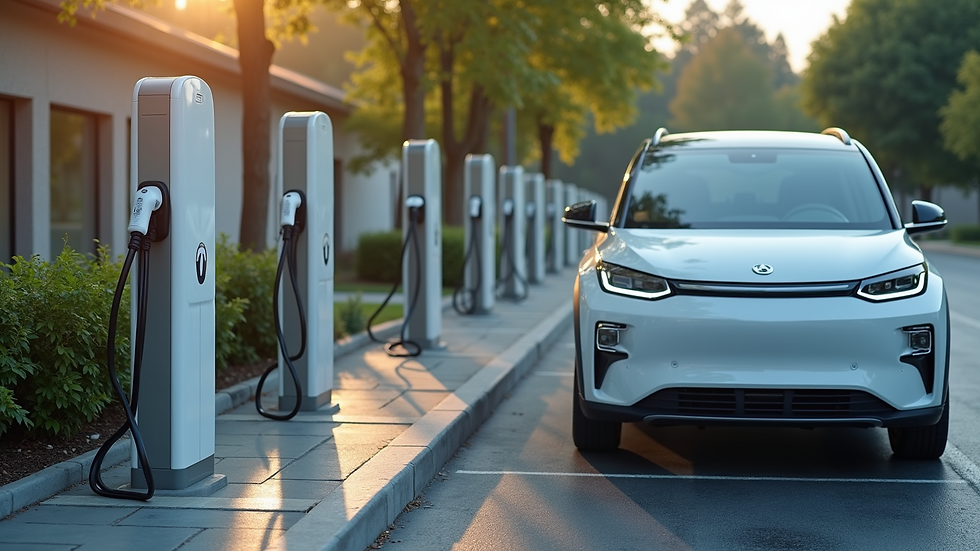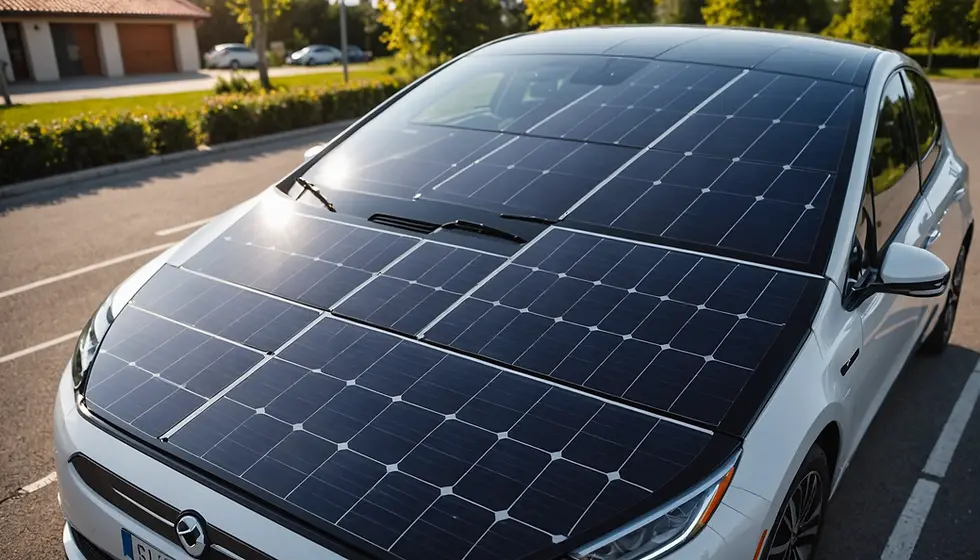Revolutionizing Mobility: The Future of Self-Charging Electric Vehicles
- Menno Drescher

- Sep 4, 2025
- 4 min read
A New Era of Electric Vehicles
The automotive world is at a major turning point. With the growing need for eco-friendly transportation, self-charging electric vehicles (SCEVs) are leading the way. A part of the ambitious "Project Genesis," the Self-Charging Electric Vehicle Program promises to change how we see and use electric cars. It focuses on allowing vehicles to create, store, and use their energy. In this post, we will dive into the objectives, benefits, and far-reaching effects of this innovative program, showcasing how it tackles the main obstacles facing electric vehicles and helps build a more sustainable future.
1.0 Program Purpose and Justification
The primary goal of the Self-Charging Electric Vehicle (SCEV) Program is to design electric cars that can virtually become self-sufficient in energy. This initiative is aimed at creating vehicles that can efficiently produce, store, and utilize energy harvested from renewable sources. Under typical conditions, these cars could arrive at their destinations with nearly a full battery.
The need for this program is clear: range anxiety and charging infrastructure are two key hurdles preventing many consumers from choosing EVs. According to a survey, 59% of potential EV buyers are concerned about running out of charge during their travels. By equipping vehicles with robust self-charging capabilities, the SCEV Program strives to change the typical electric vehicle experience. This innovation will position the organization as a leader in green driving solutions.
Additionally, vehicles equipped with this technology can interact with the power grid, allowing owners to sell extra energy back. This not only boosts the economic benefits of owning an electric vehicle but also contributes to a stronger, more sustainable energy network.
2.0 Key Features of the SCEV Program
2.1 Energy Generation
Energy generation is the cornerstone of the SCEV Program. Vehicles will generate power through various methods, such as:
Solar Energy: By integrating photovoltaic panels into vehicles, they can directly capture sunlight and convert it into usable energy.
Regenerative Braking: This process converts kinetic energy produced during braking back into electrical energy.
Motion Energy Capture: Technologies that harvest energy while driving, further enhancing each vehicle's energy efficiency.
Together, these systems aim to create an energy-positive vehicle that allows for greater driving freedom.

2.2 Advanced Energy Management Systems
The SCEV Program will include advanced energy management systems that intelligently track and optimize energy usage. These systems can learn driving habits, local weather conditions, and energy reserves, ensuring vehicles operate as efficiently as possible. For instance, if a driver tends to use less energy during morning commutes, the car will adjust its energy consumption accordingly, improving overall efficiency.
2.3 Bidirectional Charging Capabilities
A groundbreaking feature of SCEVs is their bidirectional charging technology. This capability allows vehicles to draw energy from the grid while being able to return energy back. Vehicle owners can participate in demand response initiatives, providing energy to the grid during peak hours and earning compensation for their contributions. In 2019, U.S. residential solar battery systems earned an average of $1,250 annually through similar programs, highlighting the economic potential of this innovation.
3.0 Addressing Range Anxiety
3.1 Understanding Range Anxiety
Range anxiety remains a top barrier for many potential EV owners. Worries about limited battery life and available charging stations often prevent a switch to electric. SCEVs address this directly by allowing vehicles to charge themselves, extending their driving range and reducing dependency on charging stations.
3.2 Real-World Applications
Picture this: an SCEV owner embarks on a weekend getaway. As they drive, the vehicle captures solar energy and generates energy through braking. By the time they reach their destination, the car not only maintains its charge but could even have a surplus. Such capabilities alleviate the constant pressure of finding a charging station, making longer journeys a reality without anxiety.
4.0 The Economic Impact of SCEVs
4.1 Cost Savings for Consumers
The SCEV Program is poised to offer substantial savings for drivers. Minimizing the need for public charging means reduced energy costs. Moreover, the ability to sell back energy could add an estimated $30 monthly income for vehicle owners. This makes owning an SCEV not only attractive but financially sensible.
4.2 Job Creation and Economic Growth
The rise of self-charging electric vehicles will likely boost employment in various fields. As SCEVs gain popularity, new manufacturing plants, R&D centers, and service networks can emerge, leading to job creation in both the automotive industry and the broader economy.

5.0 Environmental Benefits
5.1 Reducing Carbon Footprint
The SCEV Program aligns with the goal of reducing carbon emissions and fighting climate change. By promoting renewable energy usage, self-charging electric vehicles help create a cleaner environment. For example, if 50% of cars on U.S. roads were electric, it could reduce greenhouse gas emissions by nearly 500 million metric tons annually.
5.2 Supporting Renewable Energy Adoption
The SCEV Program also encourages a broader acceptance of renewable energy. As more vehicles generate their energy, the demand for environmentally friendly power sources will surge. This will likely lead to increased investments in solar, wind, and other sustainable technologies.
6.0 Challenges and Considerations
6.1 Technological Hurdles
Despite its promise, the SCEV Program faces several challenges. Developing reliable and efficient energy systems requires significant investment in research. Ensuring these technologies are safe and dependable is crucial in building consumer trust.
6.2 Infrastructure Development
The success of the SCEV Program will rely heavily on the development of supportive infrastructure. With more self-charging vehicles on the road, there's a growing need for new charging stations and energy management systems. Connecting with energy companies and government organizations will be essential for creating a functioning framework that supports widespread SCEV adoption.
The Road Ahead
The Self-Charging Electric Vehicle (SCEV) Program, known as "Project Genesis," marks a major step forward in the evolution of electric transportation. By tackling key issues like range anxiety and the need for charging infrastructure, this initiative could transform the automotive sector. With a focus on energy creation, advanced management technology, and bidirectional charging, the SCEV Program is set to enhance the driving experience and support a sustainable future.
As we stand on the brink of this exciting change, it is evident that self-charging electric vehicles will be crucial in shaping the landscape of modern transportation. By leaning into innovation and sustainability, we can create a cleaner, greener world for generations to come.



Comments